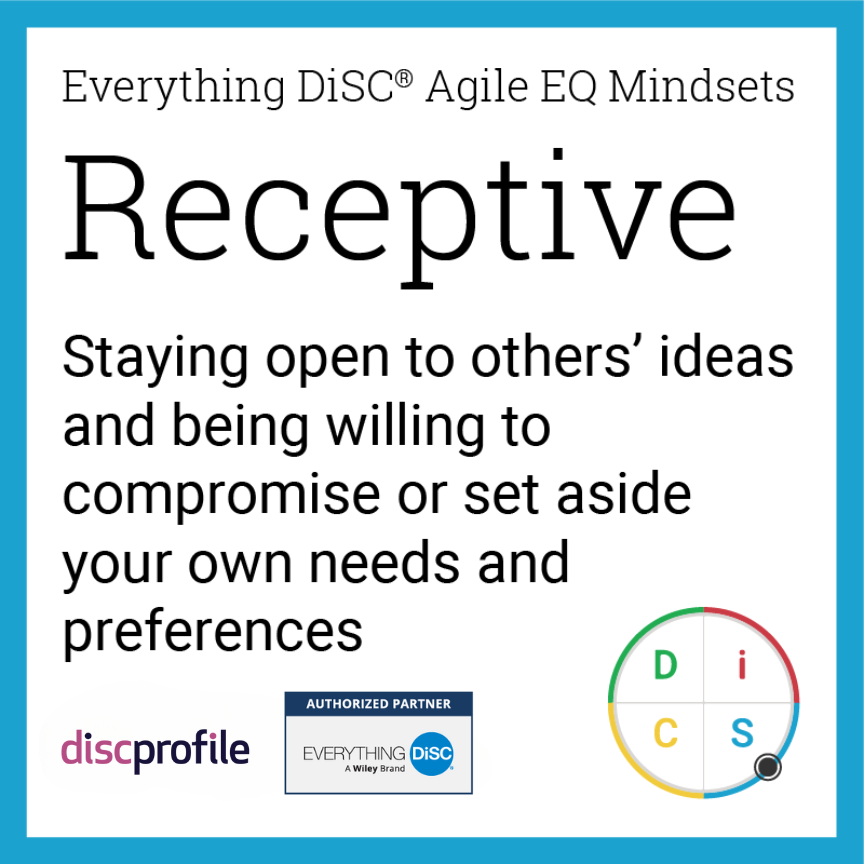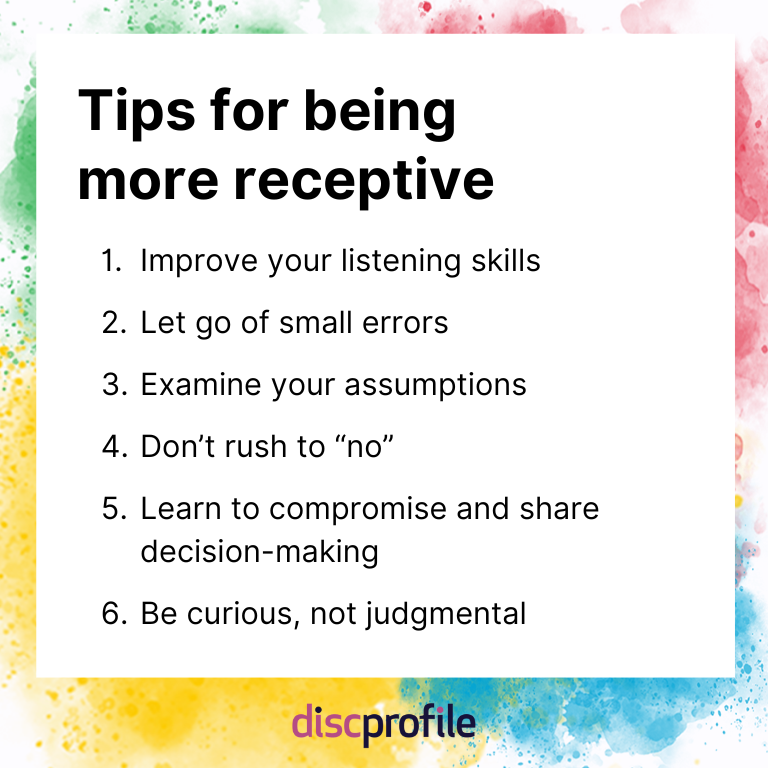How to Be More Receptive

Key Takeaways
- People with receptive personalities stay open to others’ ideas and value compromise and curiosity.
- People of all personality types may want to call upon the receptive mindset when they need to make people feel heard or consider an issue from a different perspective.
- You can practice being more receptive by cultivating curiosity, improving your listening skills, examining your assumptions, and not rushing to “no,” among other tips.
What does being receptive mean?
“I make people feel heard.”
Receptive people find value in other people’s ideas even when they conflict with their own. They excel at really considering the thoughts of others—not just letting them speak and then moving on. They don’t get locked into one vision but remain open to changing their approach as they gather new information and perspectives.
Isn’t it exciting to see things in a way you’ve never considered before? Why wouldn’t you want to take advantage of the expertise everyone brings? Receptive people value compromise and curiosity and tend to accommodate others’ needs. They are generally patient, flexible, and courteous, letting others share before speaking up.
A receptive personality often aligns with the DiSC® S style. It is one of the eight mindsets described in Everything DiSC® Agile EQ™.
Source: Everything DiSC Agile EQ
Why are some people more receptive?
The mindsets you call upon most often are driven by the needs of your personality, in this case:
- stability
- harmonious relationships
- acceptance and approval from others
- avoiding blame, criticism, or mistakes
- freedom from pressure
If these are your needs, showing up with a receptive attitude can encourage a friendly atmosphere without the tension that can be so uncomfortable for you. And while promoting your own ideas involves the risk of being wrong, letting other people’s ideas take center stage takes pressure off you. Further, listening to and supporting others can garner their acceptance and approval.
Benefits of a receptive mindset
It’s hard to overstate the benefits of being a good listener, something that comes more easily to receptive folks than others. A receptive inclination also allows you to:
- draw upon the knowledge and insight of colleagues
- arrive at stronger solutions because you’ve included multiple perspectives
- foster a harmonious environment respectful of everyone’s opinions
- act in a diplomatic way
- maintain an open mind
- set aside your own needs for the good of the group or another person
- build trust
- make room for compromise
- discover different approaches and gain critical info
Even if it takes some effort, being more receptive has specific benefits for each personality style.
- DiSC D styles can create more buy-in for their ideas when the people around them know they’ve been heard.
- i styles can build trust by making sure their excitement doesn’t push out other perspectives.
- C styles can use deep listening to gain critical information that will lead to better outcomes.
- For S styles, receptivity probably feels quite natural, and is driven by their need for stability and harmony.

Situations in which you may want to be more receptive
Agile emotional intelligence is all about being able to read the needs of a situation and choose the best mindset from which to respond. It’s not just some innate, undefinable trait some people have and some don’t—it’s a skill that you can break down into action steps and practice.
This skill development will look different for each individual, and that’s what the personalized Everything DiSC Agile EQ profiles walk you through (see sample profile). But in general, you may need to be receptive when:
- collaborating in a healthy and respectful way
- finding the best solution when multiple ideas are on the table
- balancing the needs of several parties
- making it easier for other people to feel heard
- considering an issue from a different perspective, free of your own assumptions
Limitations of the receptive mindset
Every inclination has its benefits and limitations. That’s why it is so important to adjust your approach based on the situation at hand. If you find yourself being too receptive, you may:
- give up too readily on yourself and your ideas
- sacrifice your needs, which leads to resentment
- start to see other people’s preferences as more important than your own, or become too trusting of their judgment
- support watered-down compromises or mediocre ideas to avoid hurting others’ feelings
- not have your opinions heard
If being receptive is hard for you
Recognize your thoughts
The challenges of receptivity are different for each DiSC style and each individual. Being more receptive may start by recognizing and challenging thoughts such as:
- I’m not compromising when I know my way is right.
- I’m not letting them win this one.
- Why are we wasting time when it’s clear what we should do?
- I won’t lower my standards to do things their way.
Set goals
Based on the effort meter in your Agile EQ profile, you’ll see beginner, intermediate, and advanced goals for developing into someone who can more easily access receptivity when the situation calls for it. Some examples for different styles may be:
- I make sure everyone has a say in group decisions.
- I avoid criticizing and correcting others when it isn’t necessary.
- I hear people out even if their thoughts are a little disorganized.
- I seek out input from people with very different priorities.
- I take time to challenge my own assumptions.
6 tips for becoming more receptive
Practice being more receptive by improving your listening skills, examining your skeptical first reactions, and fostering curiosity, among other tips. While the particulars will differ for each person, here is some general advice for being more receptive:
1. Improve your listening skills
To be more receptive to other’s ideas, you first have to hear them. Practice setting aside distractions when people are talking to you. Strive to become an authentic listener. Hear what people are saying, not just what you want or expect to hear.
Active listening skills are linked to positive outcomes such as job performance, relationship strength, leadership, and well-being. When done well, listening benefits both the speaker and the listener. They experience a “mutual creative thought process” that encourages innovation and clarity.
Read more about how to be a trampoline, not a sponge.
2. Let go of small errors
Inaccuracies, typos, misstatements, and the like can be quite frustrating for certain personality types. It’s easy to get distracted by these and miss the larger message.
When you encounter a small error, consider whether it’s essential to speak up or correct it at this moment. Sometimes it really is! Letting the error pass now will cause problems down the road. But if it’s something that really doesn't affect the work, realize there are times when it’s not necessary to correct the person making the error.
Researchers such as Harvard University’s Amy C. Edmondson have found that psychological safety is crucial to teams. Psychological safety demands a high-trust environment where people feel comfortable taking interpersonal risks like sharing imperfect ideas or speaking informally. When you over-correct small errors, you can inadvertently shut down dialogue and prevent useful input from surfacing.
3. Examine your assumptions
If it’s difficult for you to be receptive, it might be due to your natural skepticism. This skepticism likely serves you well in many situations and helps you be more objective. Just be sure you’re directing some of that skepticism inward, as well.
When someone shares an idea and your first reaction is to be skeptical, take a moment to notice and critique what assumptions you’re making. Don’t dismiss a new idea right away. Ask follow-up questions to make sure you’re understanding the full picture. Also, consider what personal biases might be driving your initial reaction.
A simple exercise you can try is “consider the opposite,” a bias-reducing strategy studied by researchers since the 1980s. If you think a certain product won’t sell, list a few reasons the product will sell. If you think applicant A is right for the job, list a few reasons applicant B is a better choice. This exercise can reduce confirmation bias, anchoring effects, hindsight bias, and more.
It’s easy to get locked into a certain vision in our minds, then automatically reject proposals that don’t fit the vision. This rigidity can cause us to miss opportunities to make our work and our team’s work better.
4. Don’t rush to “no”
You might excel at spotting problems and predicting all the ways a new project or process won't work. This is a valuable skill that can set your team up for success. But once in a while, instead of automatically rejecting ideas you see as half-baked, look for ways to say yes.
Use your problem-spotting superpowers to help improve the idea. If it were to work, what changes would be needed? Talk about which aspects of the idea are strongest. You might have a firm conviction about how things should be done, but is this idea wrong just because it’s not how you would approach it?
It may feel like a waste of time to entertain an idea you think is bad. But when you invite a colleague or someone you manage into constructive collaboration, rather than dismissing them outright, you build trust. You make it more likely that team members will share ideas in the future. Critique can stifle innovation.
Engaging in dialogue helps colleagues strengthen and clarify their thinking. This openness builds team cohesion and often results in more robust, well-tested ideas.
5. Promote shared decision-making (and learn when to compromise)
Like all of these tips, the suggestion to compromise is situation-dependent. Review the list above of situations where receptivity is helpful. If you’re in a situation where maintaining harmony and making everyone feel heard is critical, channeling a receptive mindset might help you compromise.
Participative decision-making often leads to better outcomes—as well as boosting employee commitment and engagement. When you involve others in decisions and show a willingness to compromise, you send a clear message that you value diverse perspectives and see your team as collaborators, not just contributors.
If you’re a leader promoting shared decision-making, be clear about roles and expectations from the start. Be upfront about who has input, who has influence, and who has final say. How will you demonstrate you are considering everyone’s perspective seriously, even if you end up going a different direction?
There are few things as demoralizing as having your opinion requested then ignored. Why did you ask me if you were just going to do what you wanted to anyway? A receptive and inclusive leader sets the tone by explaining how the decision will be made and encouraging honest input within that structure.
6. Be curious, not judgmental
Curiosity is at the core of what makes receptive people tick. In fact, all of the suggestions above could be reduced to this: be curious. When you’re curious, you listen better, you’re interested why others think the way they do, and you’re less likely to be stubbornly set in your ways.
In your interactions with coworkers, curiosity opens doors that criticism closes. There’s a strong business case for curiosity, but most leaders stifle it, consciously or unconsciously.
If you don’t feel particularly curious some days, you can trick your mind with the thought experiment, “What would a curious person do/think/ask in this situation?” Make a habit of consulting people with different areas of expertise. How can their perspective make your work better? In what ways could you collaborate?
The advice “Be curious, not judgmental” struck a chord with many people after its appearance in an episode of the TV show Ted Lasso. You can get the phrase printed on t-shirts and coffee mugs. (I was curious if the quote really came from Walt Whitman, as claimed on the show—it did not.)
It’s a simple sentiment, maybe, but it carries a lot of weight. And there’s a reason it resonated with so many people. Curiosity helps you retain new information, think creatively, build meaningful relationships, and even live longer.

Everyone has natural tendencies—instinctive responses that allow them to stay in their comfort zone. But when you over-rely on your innate attitudes, it can distort the way you look at the world. Learning to stretch into other mindsets expands your range and helps you find the best response to the situation at hand.
If you’re not a naturally receptive person, it may seem difficult or even mistaken to try these things. The Agile EQ assessment and training follow a “discover, learn, act” format that gives you insight into your natural mindsets, helps you discover the value of other mindsets, and gives you action steps to gain skills in all eight of them. Some of the mindsets will always take more effort for you, but they’ll get easier with practice.
Posted 08/24/2020, Last Updated 04/07/2025







